Getting all that a horse has to give was the overarching theme of Charlotte Dujardin’s symposium in Los Angeles, March 8–9, the first U.S. appearance for the 2012 Olympic dressage individual and team gold medalist from Great Britain. Generating forward momentum and getting the horse to maintain it, controlling every stride in upper-level movements and riding every transition and movement as if it were test time were among Charlotte’s key strategies for maximizing a horse’s potential.
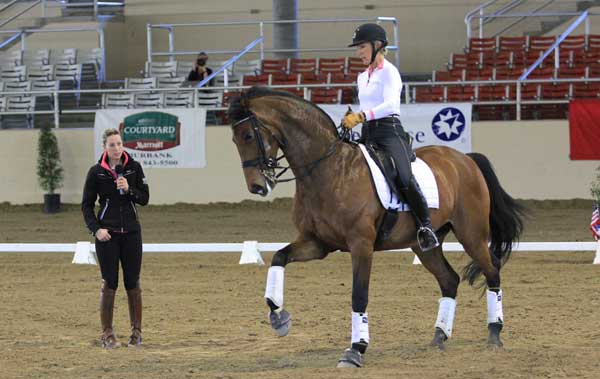
Charlotte is recognized as one of the most naturally talented riders in the world. “The only downside with Charlotte is that she doesn’t know how she does it,” reported Judy Harvey, Charlotte’s co-instructor. An international Grand Prix rider and FEI dressage judge, Judy had coached the now-28-year-old star for four years before recommending her to Carl Hester, Charlotte’s London Games’ teammate, friend and employer as a professional rider.
Judy helped articulate some of the many things Charlotte famously does by feel. “I do sort of know what I’m doing, but as to how … ” Charlotte paused. “Hmmm. It’s a feeling that I have inside me, which I can then put on the horse.”
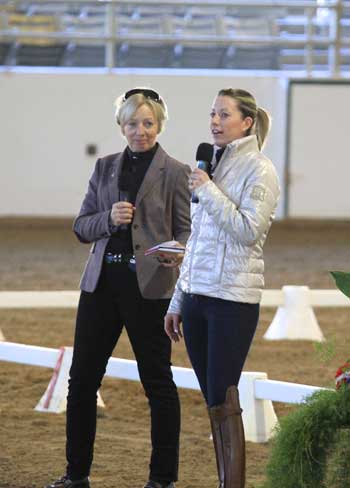
After Judy asked for the audience’s support for riders willing to brave “the ordeal of being a guinea pig,” Kristina Harrison-Antell trotted into the Los Angeles Equestrian Center’s Equidome aboard her gray Hanoverian, Barnaby Wilde GCF. Now competing at First Level, the 5-year-old was started less than a year ago, giving Charlotte and Judy an entrée to discuss their priorities in a young horse.
Good paces, especially the walk and canter, and “a desire to keep going” are Charlotte’s top priorities. “You can’t change the walk or canter much, but you know you can create a good trot,” she explained, foreshadowing discussions of developing push and suspension. “I hate to kick and I like to steer,” she added regarding her preference for hot, energetic horses, especially in prospects for international championships. “There you have three classes, and with a lazy horse, you’ll be absolutely exhausted at the end.”
Evaluating a young horse’s natural gaits is essential. “A donkey can move big if you shake a plastic bag at it,” Charlotte asserted. Gaits also can look much different under a rider’s weight.
Temperament and trainability trumped big movements for Charlotte and Judy, and they described the horse “that wants to please and work for you” as the ideal.
“Those stallion shows are like a sweet shop,” Charlotte said. “Hundreds of horses get graded high for where they are as young horses, but how many of those come through as Grand Prix horses?” Charlotte’s Olympic partner, Valegro, was a big-moving champion as a 4-, 5- and 6-year-old, but it was his willingness to work that enabled Charlotte to train the collection needed to succeed at Grand Prix. “That’s what is so brilliant about dressage. You never know how good a horse is going to be until you get there.” Added Judy, “Otherwise it would be a means test. But dressage is not that. It’s all about training and riding.
“The bigger the movements, the bigger the mistakes,” Judy noted as one reason some young equine stars don’t get to Grand Prix. “Sometimes the big canters will struggle with the small steps.”
Barnaby embodied the clinicians’ young-horse preferences in his relaxed way of going and flowing, rhythmic, balanced canter. His natural step underneath himself indicated potential for adjustability and suspension. The fact that his stifles, hocks and fetlocks all flexed to the same degree was another indicator of lovely gaits and potential.
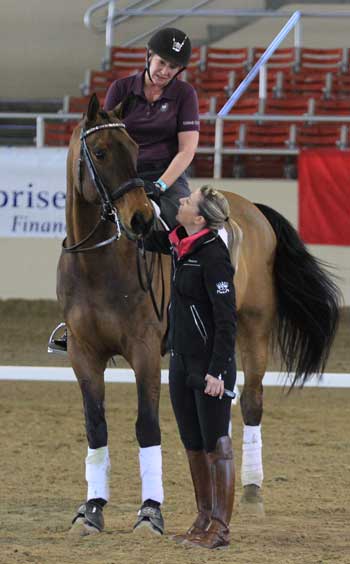
“I never do sitting trot on young horses,” said Charlotte as she instructed Kristina to work on leg-yields and trot accelerations in rising trot with the goal of strengthening the hindquarters and teaching reaction to the leg aids. “When they are 4, 5 and 6, what’s most important is getting their backs strong and having them go forward equally in both reins.” Judy noted that Barnaby’s loose, swinging tail indicated a relaxed back.
Charlotte said Barnaby’s forehand-heaviness when asked to accelerate was normal in young horses because their hind ends aren’t yet strong enough to provide the lift needed for uphill carriage. Kristina was initially tentative about pressing her leg on for more pace because it caused Barnaby to break into the canter. “That’s OK because at least it’s a reaction to the forward cue,” Charlotte said. “Don’t worry about that and don’t punish him for it.”
Charlotte encouraged frequent walk breaks for young Barnaby, but she insisted on a bright, lively walk. “Often a judge asks for more purpose in the walk, so the rider starts kicking and pushing and ruining the walk all together. A horse should walk on his own. You should not have to influence it in any way.” She applied the same strictness to riding a transition down to the walk. “It’s so important to do every transition the way you want to do it in the [show] arena,” she said. Those who neglected that clinic mantra were made to repeat the transition in competition form.
Charlotte capped the second day of work with Kristina and Barnaby with a low-key introduction to flying lead changes. She had Kristina counter-canter most of the long side then, “give a little aid—a little flick with the heel—and see what happens.” Barnaby’s first few responses were to kick out and then make the lead change, for which he got a quick pat of reward—never a reprimand—from his rider. The changes improved with each of four or five repetitions. “A young horse just learning tends to get tense and want to run away from the change,” Charlotte explained. “This way we’ve made it an excitement for him, and he’s learned to enjoy the change.
“The next step is that the horse will start doing flying changes everywhere, when you want a simple change or a counter-canter.” That can be frustrating for the rider, she acknowledged, but it should be recognized as a horse wanting to please by anticipating his rider’s requests.
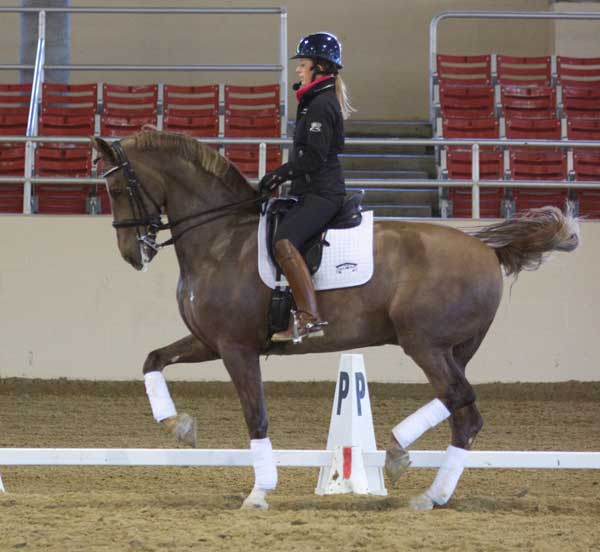
Working later with more advanced horses, Charlotte said she usually schools lead changes on the rail rather than on the diagonal. “It teaches the horse to get the change by pushing forward, rather than by swinging side to side,” she explained. The result: a straighter, bigger change.
Keep Them Guessing
The question of who’s in control arose pointedly with more advanced horses whose desire to be one step ahead of their riders contributed to upper-level movements made dull by autopilot execution. Variety and the element of surprise remedied that.
At Carl Hester’s yard in Gloucestershire County, there is a weekly routine that Charlotte said shocks many for its “chilled out” nature. Horses are schooled just four days a week. Each session starts with 15 to 20 minutes of stretching followed by 40–45 minutes of schooling for the Grand Prix horses. Two days a week, the horses are hacked in fields and along open roads, no matter what the weather is like. “You’re going to have to ride a test in rain and wind someday, so the horses best be used to it,” Charlotte explained. The seventh day is purely pasture time. “Having that shut-off time is really important,” she added.
For schooling, Charlotte eschews “the same old, boring trot round the ring.” She favors frequent transitions within and between gaits and bits and pieces of a test—rarely the whole test. “That way he’s waiting for you to see what’s next.” Clinic riders worked on establishing control of their horses’ body parts through movements that varied according to each horse’s level, such as shoulder-fore, shoulder-in, travers (haunches-in), often in 20- and 10-meter circles, half-pass, leg-yield and a few strides of piaffe and/or passage. The intent was to make the horse tune in to the rider’s every cue. When that happened, movements at every level were visibly crisper and more elevated in work that also served to supple and strengthen the horse’s body.
Even the Olympic champion Valegro benefits from this system. He gets “very hot” in his one-tempi lead changes, Charlotte shared. To counter that, she often schools two- and four-tempis in unpredictable patterns. “Making him wait for me enables me to put leg on, and that gets us much better changes.
“At home, it’s all about exercises that make our test movements better. It’s as if we were training a gymnast,” Charlotte stated. “You want to keep the horse as loose and supple as possible,” all the while insisting on the quality of work expected in competition. “When training on your own, it’s so important to be disciplined about all the little details.”
A Favorite Exercise
The clinic’s only amateur rider, Sheryl Ross, and her 13-year-old Dutch Warmblood Lancaster were the first to tackle one of Charlotte’s favorite exercises. Reserve champs at the U.S. Dressage Federation National Finals at Intermediaire I last year, the pair prepped for pirouette and perfected passage to best tackle Intermediaire II. Charlotte shared the following exercise that she and Carl use frequently as pirouette prep:
1. Going to the right, canter through the corner on the right lead.
2. Continue three strides in shoulder-fore to set up a …
3. half-pass to the centerline.
4. Ride a few strides of right shoulder-fore on the centerline.
5. Canter half a 10-meter circle going right, with the haunches in and turning the shoulders around the circle.
6. Half-pass right back to the rail.
“This is good for working the pirouette because it makes you ride the front end,” Charlotte explained. “And it’s really useful to be able to position the horse’s shoulders and to concentrate on riding the canter with forwardness and rhythm,” Judy added.
Sheryl was one of many to receive Charlotte’s shouted “Let go! Let go! Let go!” instructions. Having been a little heavy-handed herself in earlier years, Charlotte spoke from experience in urging riders to treat the rein as a slow/stop aid and lighten it when they want that all-important forward motion from their horses. When Sheryl softened her hands to ask Lancaster for passage, it transformed a previously constricted gait into a floating, forward applause-earner.
“It’s fabulous to see the change in attitude when a horse feels that he has so much more to give,” Judy observed. “His eyes are soft and it looks like he’s saying ‘Gee, this is fun!’”
Mette Rosencrantz and the 13-year-old Danish Warmblood mare Cenna worked on full pirouettes. Charlotte first fixed the pilot error of not dividing the movement’s typically six to eight strides evenly on either side of the centerline. She also positioned herself in such a way that Mette had to keep the pirouette in place or run over the gold medalist. “I’m not watching out for you, you watch out for me!” Charlotte told Mette.
Mette needed to keep control of every stride through the turn and maintain a solid canter to avoid having her mare get stuck in the second half and make a sloppy exit from the pirouette. Correcting a slack outside rein to use both reins to control and lift the shoulders through the move was effective. Charlotte recommended travers work to make Cenna’s right side more supple. It was hard work and Charlotte suggested “something really easy”—like a relaxed working trot—for cool-down to end the session on a good note.
Although Charlotte said she was “terrified” of teaching 1976 Olympic bronze medalist and international judge Hilda Gurney, she cut the living legend no slack. (And Hilda would have it no other way.) Riding her 18-hand homebred Oldenburg gelding Wintersnow, Hilda wanted to polish his piaffe and passage for their third year of Grand Prix competition.
Charlotte had ridden the stunning, all-white-since-birth gelding the day before and described him as a horse who got “too engaged” to the point of “getting all balled up.”
With the goal of gaining more responsiveness to the leg, especially the left leg, Charlotte loved the “good ol’ kick” Hilda laid on while trotting on the long side, as requested. “Asking for sensitivity to your leg in a simple move makes it very clear to the horse—black and white—what you are asking for.” Charlotte had Hilda ask for passage in the rising trot to encourage a looser, more raised back and to better keep Wintersnow in front of the leg. Trot/passage/trot transitions added roundness toward an end result of a lovely, relaxed-looking passage. Said Judy, “It’s easy to say, ‘Hey, we’re doing passage!’ and get a 6 or a 7, when there’s sometimes an 8 or a 9 in there.”
Charlotte told the audience and most of the clinic’s riders to “lose your whip dependency,” so there were several available when she asked Hilda’s permission to apply one from the ground with Wintersnow for work in passage and piaffe.
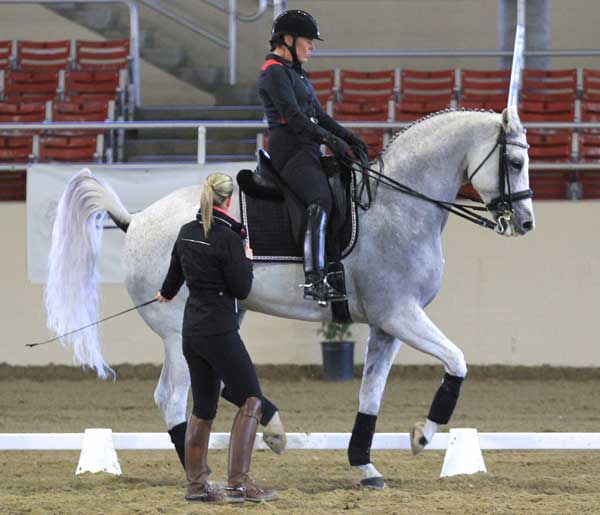
Tapping it lightly at the gelding’s croup to encourage the “sit” she wants for piaffe and above the hock for the “push” required for passage, Charlotte helped Hilda bring on the brilliance.
Clinic auditors would have left happy after the session with Hilda, but the show was far from over when Canadian Olympian Leslie Reid rode into the ring on her 8-year-old Pura Raza Española stallion Kobal, then dismounted. After watching Leslie’s “baby” the day before, Charlotte had chosen him to ride on Saturday. Complimenting Leslie for the “amazing job” she’d done since getting him in Spain as a 3-year-old, Charlotte described Kobal as “lovely in his contact and nice off my leg” with “exceptional movement, temperament and gymnastic ability.”
While warming up the horse on loose contact at a working trot, Charlotte talked about the difference between “just riding” a movement and “letting it be expressive.” She demonstrated the idea later in a series of one-tempi lead changes with Kobal in front of her leg and a hand that maintained contact “but is always thinking forward.” Thus engaged, the horse pushed himself forward through changes that were big and lively yet looked effortless. “When you have a horse in front of your leg, you can pretty much do anything you want,” Charlotte said. “You want that feeling that your horse is taking you. Especially in the Grand Prix, where everything comes up so quickly.
“Leslie has really taken her time with this horse,” Charlotte continued. “She’s put a little bit of passage into his half-pass,” Charlotte explained while trotting a forward and sideways track in front of the crowd. “Riding forward with that suspension is where you get the 9s. And that’s why we don’t worry about the trot in a young horse. You know you can create it when you create that suspension.”
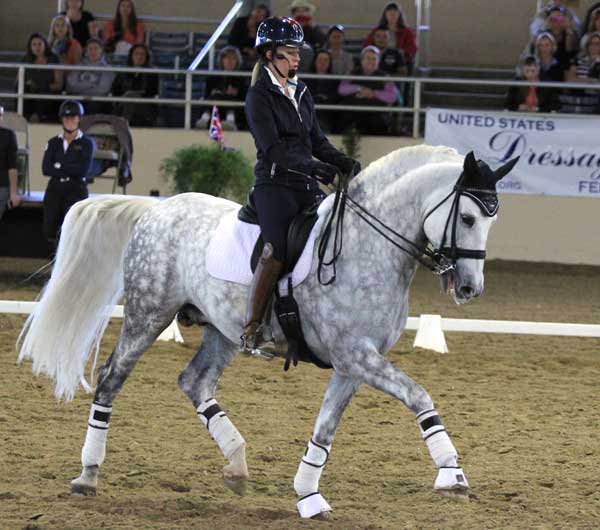
After each day’s session, Charlotte and Judy took audience questions, one of which elicited the gold medalist’s favorite Olympic moment: Her and Valegro’s entrance into the arena in London ignited a round of clapping and cheers from the hometown crowd. “He clammed up,” Charlotte recalls of “Blueberry’s” reaction to that typically taboo audience response. “I patted him to say ‘it’s OK’ and I felt that release in him. When you get that, you know you have that connection and partnership with your horse.”
In a weekend’s worth of setting forth high standards, that level of connection and partnership was one that all riders and audience members could aspire to. As for the level of riding Charlotte demonstrated, her natural gifts may be hard to replicate but the tools and tips she provided can help everybody be more brilliant.










